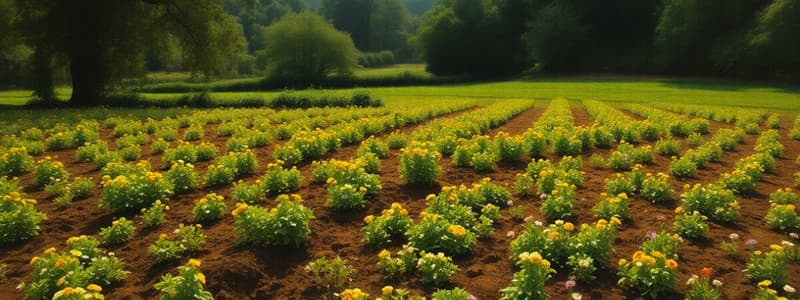Podcast
Questions and Answers
What are the three major soil separates that make up soil texture?
What are the three major soil separates that make up soil texture?
Sand, silt, and clay.
Describe the characteristics of sandy soil.
Describe the characteristics of sandy soil.
Sandy soil has large particles, feels gritty, drains quickly, and holds little water and nutrients.
What are the effects of clay soil on water retention?
What are the effects of clay soil on water retention?
Clay soil has a high water retention capacity but drains poorly.
Explain how soil texture influences nutrient holding capacity.
Explain how soil texture influences nutrient holding capacity.
How does the presence of silt affect soil drainage and water retention?
How does the presence of silt affect soil drainage and water retention?
Why are loamy soils considered ideal for root growth?
Why are loamy soils considered ideal for root growth?
What makes fine-textured soils more prone to erosion?
What makes fine-textured soils more prone to erosion?
What challenges might a farmer face when dealing with sandy soils?
What challenges might a farmer face when dealing with sandy soils?
Flashcards are hidden until you start studying
Study Notes
Soil Texture
- Relative proportions of sand, silt, and clay particles determine soil behavior
- Sand: Largest particles, gritty texture, poor water retention, drains quickly, low nutrient holding capacity
- Silt: Medium-sized particles, smooth and floury when dry, slippery when wet, better water retention than sand, drains slower than sand
- Clay: Smallest particles, sticky when wet, hard when dry, excellent water and nutrient retention, drains poorly, prone to compaction
Importance of Soil Texture
- Water Retention and Drainage: Sandy soils drain quickly and hold little water, clay soils retain water but drain poorly
- Nutrient Holding Capacity: Clay soils hold more nutrients, sandy soils require more frequent fertilization
- Root Penetration: Loamy soils (balanced mixture of sand, silt, and clay) are ideal for root growth due to good drainage and support
- Erosion Susceptibility: Fine-textured soils (high silt or clay) are prone to water erosion, sandy soils are vulnerable to wind erosion
Studying That Suits You
Use AI to generate personalized quizzes and flashcards to suit your learning preferences.




